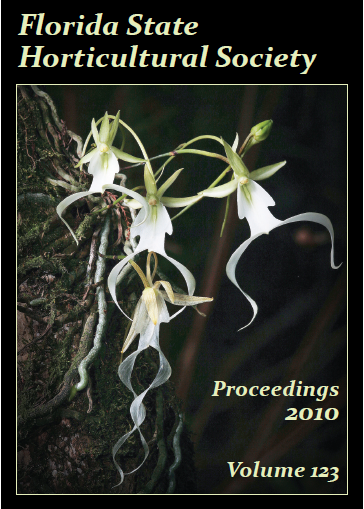Vegetable
Resumen
Keeping water and nutrients within the rootzone of vegetable crops is the main goal of nutrient Best Management Practices. Because the actual depth of water movement below a crop depends on the volume of water applied and how much water is taken up by the plant, it is possible that reducing drip irrigation system operating pressure (OP) as a means to increase the length of irrigation time may result in slower vertical water movement due to 1) greater lateral water movement and 2) increased plant water uptake. Without a crop, water moved in a deep sandy soil at rate of 0.057 to 0.17 mm/L/100 m (0.3 to 0.9 inch/10 gal/100 ft). Assuming a typical daily irrigation schedule of 2 h using a flow rate of 300 L/100 m/h (24 gal/100 ft/h), the estimated wetted soil depth would be 216 to 650 cm (86 to 260 inches) after 60 d. In this study, tomato plants were grown for two seasons using plasticulture. Treatments were OP of 41 and 82 kPa (6 and 12 psi) and two irrigation rates of 100% and 75% of the UF-IFAS recommended rate. Blue dye was injected on 14 and 21 DAT and the soil was dug on 80 and 84 DAT in 2008 and 2009, respectively. The depth of waterfront was significantly affected by OP (P = 0.01) with maximum average wetted depths of 130 and 158 cm (52 and 63 inches) at 42 kPa (6 psi), and 160 and 168 cm (64 and 67 inches) at 84 kPa (12 psi), respectively, for 2008 and 2009. Surprisingly, irrigation rate effect was not significant on the depth of waterfront at 145 and 165 cm (58 and 66 inches) at 100% IRR and 143 and 163 cm (57 and 65 inches) at 75% IRR in 2008 and 2009, respectively. While reducing OP significantly reduced the downwards movement of water in the soil, it was not sufficient to keep the irrigated water from moving beyond the crop rootzone on a sandy soil. Hence, reduced OP should not be relied upon as a panacea, but should be used together with other nutrient BMPs.Citas
- Clothier, B.E. and T.D. Heiler. 1983. Infiltration during sprinkler irrigation: Theory and field results. In: Advances in infiltration. ASAE Publ., 11-83, Amer. Soc. Agr. Eng., St. Joseph, MI, p. 275–284.
- Clothier, B.E. and S.R. Green. 1994. Rootzone processes and the efficient use of irrigation water. Agr. Water Mgt. 25:1–12.
- Dowgert, D., B. Marsh, R. Hutmacher, D. Hannaford, J. Phene, and C. Phene. 2007. Low pressure drip irrigation lessens agricultural inputs. Intl. Water Technol. and Ozone V Conf. Intl. Ctr. for Water Technol. <http://www.icwt.net>. Accessed 22 Jan. 2010.
- Farneselli, M., D.W. Studstill, E.H. Simonne, R.C. Hochmuth, G.J. Hochmuth, and F. Tei. 2008. Depth and width of the wetted zone in a sandy soil after leaching drip-irrigation events and implications for nitrate-load calculation. Comm. Soil Sci. and Plant Anal. 39:1183–1192.
- Florida Department of Agriculture and Consumer Services (FDACS). 2005. Water quality/quantity Best Management Practices for Florida vegetable and agronomic crops. <http://www.floridaagwaterpolicy.com/PDF/Bmps/Bmp_VeggieAgroCrops2005.pdf>. Accessed 10 May 2010.
- Levin, L., P.C. van Rooyen, and F.C. van Rooyen. 1979. The effect of discharge rate and intermittent water application by point-source irrigation on the soil moisture distribution pattern. Soil Sci. Soc. Amer. J. 43.
- Natural Resources Conservation Service (NRCS, USDA). 2006. Soil survey of Suwanee County, Florida, p. 394. <http://soildatamart.nrcs.usda.gov/Manuscripts/FL121/0/ Suwannee.pdf>. Accessed 22 Jan. 2010.
- Olson, S.M., W.M. Stall, G.E. Vallad, S.E. Webb, T.G. Taylor, S.A. Smith, E.H. Simonne, E. McAvoy, and B.M. Santos. 2009. Tomato production in Florida, p. 291–312. In: S.M. Olson and E. Simonne (eds.). Vegetable production handbook for Florida 2009–2010. Vance Publ., Lenexa, KS.
- Ouchi, S., A. Nishikawa, and E. Kamada. 1990. Soil-improving effects of a super-water-absorbent polymer (part 2). Evaporation, leaching of salts and growth of vegetables. Jpn. J. Soil Sci. Plant Nutr. 61(6):606–613.
- Poh, B.L., E.H. Simonne, R.C. Hochmuth, and D.W. Studstill. 2009. Effect of splitting drip irrigation on the depth and width of the wetted zone in a sandy soil. Proc. Fla. State Hort. Soc. 122:221–223.
- Sainju, U.M., B.P. Singh, and S. Yaffa. 2002. Soil organic matter and tomato yield following tillage, cover cropping and nitrogen fertilization. Agron. J. 94(3):594–602.
- SAS. 2008. SAS/STAT 9.2 User’s guide. SAS Inst., Cary, NC.
- Simonne, E., M. Dukes, R. Hochmuth, G. Hochmuth, D. Studstill, and W. Davis. 2002. Long-term effect of fertilization and irrigation recommendations on watermelon yield and soil-water nitrate levels in Florida’s sandy soils. Acta Hort. 627:97–103.
- Simonne, E.H., D.W. Studstill, R.C. Hochmuth, G. McAvoy, M.D. Dukes, and S.M. Olson. 2003. Visualization of water movement in mulched beds with injections of dye with drip irrigation. Proc. Fla. State Hort. Soc. 116:88–91.
- Simonne, E., D. Studstill, and R.C. Hochmuth. 2006. Understanding water movement in mulched beds on sandy soils: An approach to ecologically sound fertigation in vegetable production. Acta Hort. 700:173–178.
- Simonne, E.H. and M.D. Dukes. 2009. Principles and practices of irrigation management for vegetables,pp.17–23. In: S.M. Olson and E. Simonne (eds.). Vegetable p roduction handbook for Florida 2009–2010.Vance Publ., Lenexa, KS.
- Simonne, E., C. Hutchinson, J. DeValerio, R. Hochmuth, D. Treadwell, A. Wright, B. Santos, A. Whidden, G. McAvoy, X. Zhao, T. Olczyk, A. Gazula, and M. Ozores-Hampton. 2010. Current knowledge, gaps and future needs for keeping water and nutrients in the root zone of vegetables grown in Florida. HortTechnology 20(1):143–152.
- Zhang, M., Y.C. Li, and P.J. Stoffella. 2003. Nutrient availability in a tomato production system amended with compost. Acta Hort. 614(2):787–797.

